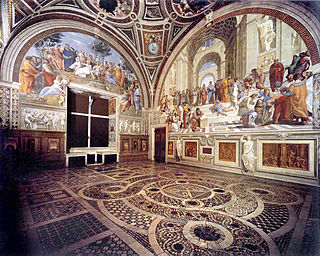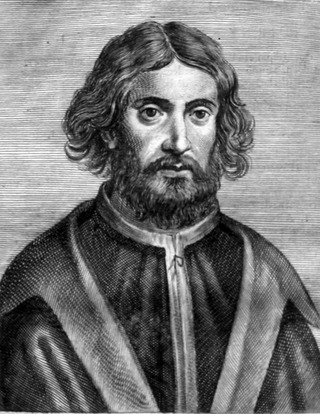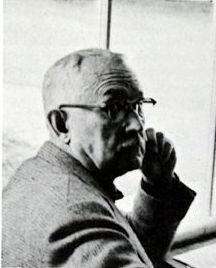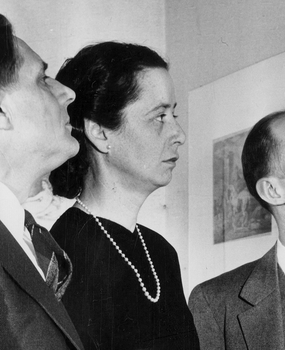Related Research Articles

Mannerism is a style in European art that emerged in the later years of the Italian High Renaissance around 1520, spreading by about 1530 and lasting until about the end of the 16th century in Italy, when the Baroque style largely replaced it. Northern Mannerism continued into the early 17th century.

In art history, the High Renaissance was a short period of the most exceptional artistic production in the Italian states, particularly Rome, capital of the Papal States, and in Florence, during the Italian Renaissance. Most art historians state that the High Renaissance started between 1490 and 1500, and ended in 1520 with the death of Raphael, although some say the High Renaissance ended about 1525, or in 1527 with the Sack of Rome by the army of Charles V, Holy Roman Emperor, or about 1530. The best-known exponents of painting, sculpture and architecture of the High Renaissance include Leonardo da Vinci, Michelangelo, Raphael, and Bramante. In the 21st century, the use of the term has been frequently criticized by some academic art historians for oversimplifying artistic developments, ignoring historical context, and focusing only on a few iconic works.

Il Sodoma was the name given to the Italian Renaissance painter Giovanni Antonio Bazzi. Il Sodoma painted in a manner that superimposed the High Renaissance style of early 16th-century Rome onto the traditions of the provincial Sienese school; he spent the bulk of his professional life in Siena, with two periods in Rome.
Richard Theodore Titlebaum was a writer, artist, antiquarian book collector and literature professor.
Sir Nicholas Beaver Penny is a British art historian. From 2008 to 2015 he was director of the National Gallery in London.
John Kinder Gowran Shearman was an English art historian who also taught in America. He was a specialist in Italian Renaissance painting, described by his colleague James S. Ackerman as "the leading scholar of Italian Renaissance painting", who published several influential works, but whose expected major book on Quattrocento painting, for the Penguin/Yale History of Art series, never appeared. However, what is widely acknowledged as his most influential book, on the concept of Mannerism, published in 1967, is still in print.

Palma Vecchio, born Jacopo Palma, also known as Jacopo Negretti, was a Venetian painter of the Italian High Renaissance. He is called Palma Vecchio in English and Palma il Vecchio in Italian to distinguish him from Palma il Giovane, his great-nephew, who was also a painter.

Counter-Maniera or Counter-Mannerism is a term in art history for a trend identified by some art historians in 16th-century Italian painting that forms a sub-category or phase of Mannerism, the dominant movement in Italian art between about 1530 and 1590. Counter-Maniera or Counter-Mannerism reacted against the artificiality of the second generation of Mannerist painters in the second half of the 16th century. It was in part due to artists wishing to follow the vague prescriptions for clarity and simplicity in art issued by the Council of Trent in its final session in 1563, and represented a rejection of the distortions and artificiality of high Mannerist style, and a partial return to the classicism and balance of High Renaissance art, with "clarity in formal order and legibility in content".

Joseph Leo Koerner is an American art historian and filmmaker. He is the Victor S. Thomas Professor of the History of Art and Architecture and Professor of Germanic Languages and Literatures at Harvard University. Since 2008 he has also been Senior Fellow at the Harvard's Society of Fellows.

Tarquin and Lucretia is an oil painting by Titian completed in 1571, when the artist was in his eighties, for Philip II of Spain. It is signed, and considered to have been finished entirely by Titian himself. It is one of a series of great works from Titian's last years, but unlike some of these, is fully finished. It is now in the Fitzwilliam Museum in Cambridge, England.
Ian Lorne Campbell is a Scottish art historian and curator. Campbell was Beaumont Senior Research Curator at the National Gallery, London from 1996 to 2012, and from 1974 to 1996 lectured on the Northern Renaissance at the Courtauld Institute of Art, University of London. He has curated major exhibitions at the National Gallery and other museums, including ones on Rogier van der Weyden at Leuven in 2009 and the Prado in 2015.

Janet Cox-Rearick was an American art historian, Distinguished Professor of Art History at the City University of New York.
Marjorie Elizabeth Cropper is a British-born art historian with a special interest in Italian and French Renaissance and Baroque art and art literature. Dean of the National Gallery of Art’s Center for Advanced Study in the Visual Arts (CASVA) since December 2000, she previously held positions as Professor of Art History at Johns Hopkins University and director of the university’s Charles S. Singleton Center for Italian Studies at Villa Spelman in Florence.

Patricia Fortini Brown is Professor Emerita of Art & Archaeology at Princeton University.
Luke Syson is an English museum curator and art historian. Since 2019, he has been the director of the Fitzwilliam Museum at the University of Cambridge, prior to which he held positions at the British Museum (1991–2002), the Victoria and Albert Museum (2002–2003), the National Gallery (2003–2012) and the Metropolitan Museum of Art (2015–2019). In 2011 he curated the acclaimed Leonardo da Vinci exhibition at the National Gallery: Leonardo da Vinci: Painter at the Court of Milan, which included his pivotal role in the controversial authentication by the National Gallery of da Vinci's Salvator Mundi.

Meyric R. Rogers (1893–1972) was an Anglo-American curator and design historian.
Julian Richard Gardner is a British art historian and Professor Emeritus at the University of Warwick. A scholar of late medieval and renaissance Italian art, particularly patronage, and a Giotto di Bondone specialist whose expertise has led to a number of scholarships and appointments as visiting professor at various institutions both in Europe and America.

Elizabeth Mongan was an art historian and curator, an authority on prints. She assembled the Rosenwald collection of prints and joined the National Gallery of Art as a curator when the collection moved there. She authored numerous exhibition catalogs, including the seminal The First Century of Printmaking, 1400 to 1500 and the catalogue raisonné of the prints of Paul Gauguin.
Marcia Hall, who usually publishes as Marcia B. Hall, is an American art historian, who is the Laura H. Carnell Professor of Renaissance Art at the Tyler School of Art and Architecture of Temple University in Philadelphia. Hall's scholarship has concentrated on Italian Renaissance painting, mostly of the sixteenth century, and especially Raphael and Michelangelo.

Edgar Preston Richardson, also known as E. P. Richardson, was an American art historian, museum director, author, and curator. Richardson served as director of the Detroit Institute of Arts (1945–1962) and Winterthur Museum (1963–1966). He authored seven books, served on the boards of the Pennsylvania Academy of the Fine Arts (1966–1977) and other arts organizations, and co-founded the Archives of American Art at the Smithsonian in 1954.
References
- ↑ Cotter, Holland (May 8, 1997). "Sydney J. Freedberg, 82, Art Historian, Dies". The New York Times . Retrieved 2008-05-20.
Sydney J. Freedberg, an art historian who taught for nearly three decades at Harvard and was chief curator of the National Gallery of Art in Washington, died on Tuesday at his home in Washington. He was 82.
- ↑ Obituary, May 15,1997, Harvard University Gazette Archived 2011-06-29 at the Wayback Machine
- ↑ Lifetime Honors – National Medal of Arts Archived 2011-07-21 at the Wayback Machine